Themed collection Emerging inorganic materials in thin-film photovoltaics

List of participants
Faraday Discuss., 2022,239, 415-416
https://doi.org/10.1039/D2FD90067J
Poster list
Faraday Discuss., 2022,239, 413-414
https://doi.org/10.1039/D2FD90066A
Spiers Memorial Lecture: Next generation chalcogenide-based absorbers for thin-film solar cells
The lecture focuses on emerging chalcogenide-based thin-film photovoltaics and provides both an overview of selected absorber candidates that are of recent interest, and a deeper dive into an exemplary Cu2BaSn(S,Se)4-related family.
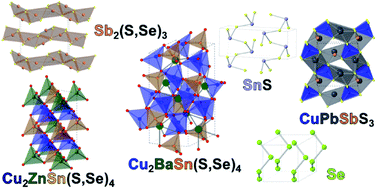
Faraday Discuss., 2022,239, 9-37
https://doi.org/10.1039/D2FD00132B
Concluding remarks: emerging inorganic materials in thin-film photovoltaics
A summary of progress in the design, discovery and optimisation of sustainable materials for solar energy conversion is presented.

Faraday Discuss., 2022,239, 405-412
https://doi.org/10.1039/D2FD00135G
Time-resolved photoluminescence studies of perovskite chalcogenides
The rates of excited-state decay through recombination processes determine the usefulness of a semiconductor for ambipolar devices. We find that recombination rates in chalcogenide perovskites are promising for continued progress towards solar cells.

Faraday Discuss., 2022,239, 146-159
https://doi.org/10.1039/D2FD00047D
The kesterite–stannite structural transition as a way to avoid Cu/Zn disorder in kesterites: the exemplary case of the Cu2(Zn,Mn)SnSe4
Cu/BII disorder is significantly reduced with Mn incorporation and the kesterite–stannite structural phase transition in Cu2(Zn,Mn)SnSe4.

Faraday Discuss., 2022,239, 51-69
https://doi.org/10.1039/D2FD00042C
Ex situ Ge-doping of CZTS nanocrystals and CZTSSe solar absorber films
Ge doping is employed to aid the recrystallisation of Cu2ZnSnS4 nanocrystals. Opto-electrical properties are presented to describe Ge incorporation with a focus on the electronic interface between the Ge:Cu2ZnSn(S, Se), absorber and CdS buffer layer.

Faraday Discuss., 2022,239, 70-84
https://doi.org/10.1039/D2FD00069E
Low temperature (Zn,Sn)O deposition for reducing interface open-circuit voltage deficit to achieve highly efficient Se-free Cu(In,Ga)S2 solar cells
Results show a low temperature atomic layer deposited (Zn,Sn)O buffer layer with optimum band alignment improves the translation of qFLs into VOC and consequently reduces the deficit between the qFLs and VOC of a Cu(In,Ga)S2 solar cell.
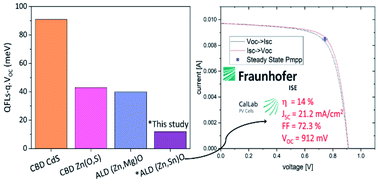
Faraday Discuss., 2022,239, 328-338
https://doi.org/10.1039/D2FD00046F
Photoluminescence assessment of materials for solar cell absorbers
Photoluminescence is used to predict the open circuit voltage. However, band gap fluctuations and tail states broaden the PL emission and can lead to underestimation of the quasi Fermi level splitting. We discuss potential errors and how to avoid them.
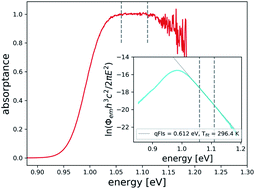
Faraday Discuss., 2022,239, 112-129
https://doi.org/10.1039/D2FD00057A
Accelerating research on novel photovoltaic materials
Massive increase of data sharing and full utilization of digitization is proposed to help accelerate novel PV material development.
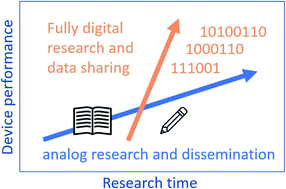
Faraday Discuss., 2022,239, 235-249
https://doi.org/10.1039/D2FD00085G
Off-stoichiometry in I–III–VI2 chalcopyrite absorbers: a comparative analysis of structures and stabilities
The capability of chalcopyrites to accept group-I deficiency without decomposing varies greatly even within a narrow family of isomorphic I–III–VI systems. Only one-third of them exhibit this property at the level seen in Cu(In,Ga)Se2.
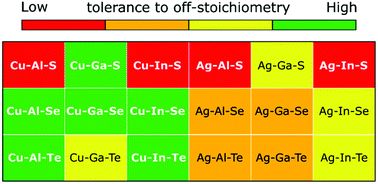
Faraday Discuss., 2022,239, 357-374
https://doi.org/10.1039/D2FD00105E
Chemical and electronic structure of the heavily intermixed (Cd,Zn)S:Ga/CuSbS2 interface
Hard X-ray photoelectron spectroscopy reveals the (Cd,Zn)S:Ga/CuSbS2 thin-film solar cell interface to be heavily intermixed resulting in a ‘cliff’-like conduction band offset.

Faraday Discuss., 2022,239, 130-145
https://doi.org/10.1039/D2FD00056C
Rapid thermal annealing process for Se thin-film solar cells
A rapid thermal annealing process assists the synthesis of the preferred [003]-oriented Se thin film with a large grain size for photovoltaic application.

Faraday Discuss., 2022,239, 317-327
https://doi.org/10.1039/D2FD00070A
A post-deposition annealing approach for organic residue control in TiO2 and its impact on Sb2Se3/TiO2 device performance
A two-step post-deposition treatment approach enables organic residue control in TiO2 and improves the efficiency of a Sb2Se3/TiO2 thin film solar cell.
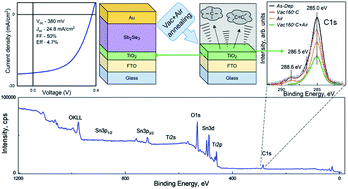
Faraday Discuss., 2022,239, 273-286
https://doi.org/10.1039/D2FD00064D
Ultrathin wide band gap kesterites
Thickness reduction of kesterite CZTS solar cells down to 250 nm is performed showing relatively small performance loss. The introduction of oxide passivation layers improves performance and a NaF treatment is used to make such back contact conductive.

Faraday Discuss., 2022,239, 38-50
https://doi.org/10.1039/D2FD00052K
GeSe photovoltaics: doping, interfacial layer and devices
Ag-doped GeSe has been successfully grown and compared to undoped GeSe with XRD, photoemissions, ICP-OES and CV. The undoped and Ag-doped GeSe were included in PV devices with the champion device structure and J–V curve shown.
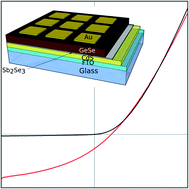
Faraday Discuss., 2022,239, 250-262
https://doi.org/10.1039/D2FD00048B
Stoichiometry modulates the optoelectronic functionality of zinc phosphide (Zn3−xP2+x)
Zinc phosphide (Zn3P2) is a promising material for photovoltaic applications. Here, we investigate the effect of stoichiometry variations and defects on the structural and optoelectronic properties of monocrystalline Zn3P2.
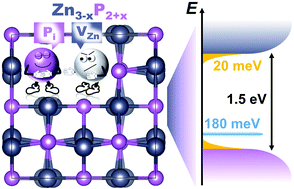
Faraday Discuss., 2022,239, 202-218
https://doi.org/10.1039/D2FD00055E
Impact of metastable defect structures on carrier recombination in solar cells
Metastable defect structures can activate novel pathways for electron–hole recombination in semiconductors – particularly for inorganic compounds with anharmonic/mixed bonding, multinary composition, low symmetry and/or highly-mobile defects.
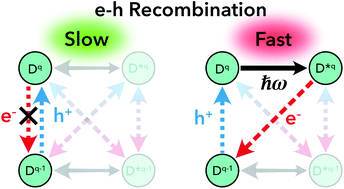
Faraday Discuss., 2022,239, 339-356
https://doi.org/10.1039/D2FD00043A
Multi-modal characterization of kesterite thin-film solar cells: experimental results and numerical interpretation
Scanning X-ray microscopy is shown to be powerful for in situ and operando studies of nanostructured devices such as CZTS solar-cells: nanoscale performance is correlated with composition, and observed trends are understood with simulations.

Faraday Discuss., 2022,239, 160-179
https://doi.org/10.1039/D2FD00044J
Zinc germanium nitrides and oxide nitrides: the influence of oxygen on electronic and structural properties
Oxygen alters the properties of semiconducting nitrides, such as ZnGeN2. We study the effect of oxygen incorporation computationally and compare the results to experimental values obtained in the system Zn1+xGe1−x(N1−xOx)2.

Faraday Discuss., 2022,239, 219-234
https://doi.org/10.1039/D2FD00041E
Comprehensive rear surface passivation of superstrate Sb2Se3 solar cells via post-deposition selenium annealing treatments and the application of an electron blocking layer
The passivation of defects associated with the Se deficiency on a rear surface of superstrate SbSe3 is acheived by post-deposition annealing treatment (PAT) under Se ambiance. The PAT greatly improves the device performance, mainly Voc and FF.
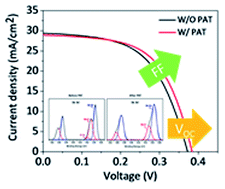
Faraday Discuss., 2022,239, 263-272
https://doi.org/10.1039/D1FD00056J
Materials design and bonding: general discussion
Faraday Discuss., 2022,239, 375-404
https://doi.org/10.1039/D2FD90058K
Novel chalcogenides, pnictides and defect-tolerant semiconductors: general discussion
Faraday Discuss., 2022,239, 287-316
https://doi.org/10.1039/D2FD90057B
Bulk and surface characterisation techniques of solar absorbers: general discussion
Faraday Discuss., 2022,239, 180-201
https://doi.org/10.1039/D2FD90056D
Indium-free CIGS analogues: general discussion
Faraday Discuss., 2022,239, 85-111
https://doi.org/10.1039/D2FD90055F
About this collection
We are delighted to share with you a selection of the papers associated with a Faraday Discussion on Emerging inorganic materials in thin-film photovoltaics. More information about the related event may be found here: http://rsc.li/photovoltaics-fd2022. Additional articles will be added to the collection as they are published. The final versions of all the articles presented and a record of the discussions will be published after the event.
This Discussion will assess the latest developments in emergent inorganic absorbers and the extent to which we can correlate and predict device performance from structural and optical properties, a swell as bringing together leading scientists in material design and modelling, structural and electronic characterisation, and device design and performance analysis. Contributions will cover chalcogenides, pnictides and oxides, particularly those in the growing field of defect-tolerant semiconductors comprising elements such as Bi, Sn, In and Sb. This meeting will cover 4 main themes: Indium-free CIGS analogues, Novel chalcogenides, pnictides and defect-tolerant semiconductors, Material design: structure and bonding and Bulk and surface characterisation techniques of solar absorbers.
On behalf of the Scientific Committee, we hope you join us and participate in this exciting event, and that you enjoy these articles and the record of the discussion.